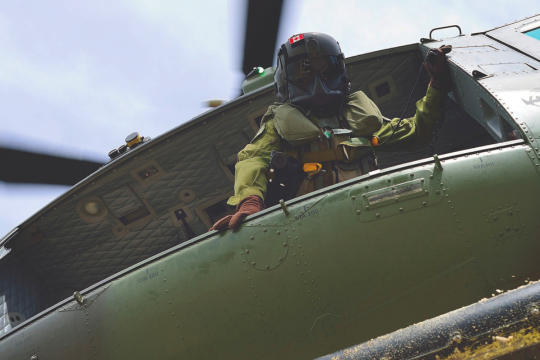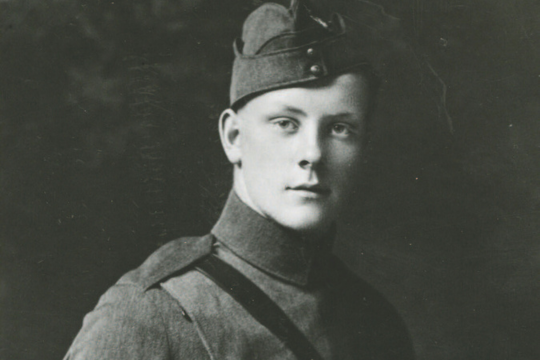
A Royal Canadian Air Force CH-146 Griffon helicopter takes off from Olotayan Island during Operation RENAISSANCE, a disaster relief operation in the Philippines in 2013. Photo: Master Cpl. Marc-André Gaudreault, Canadian Forces Combat Camera
It’s the 100th anniversary of the Royal Canadian Air Force, though the story begins a few years earlier when the world was at war.
“We didn't really have any Canadian aircraft in the First World War. Our first thing that we recognize as a Canadian military aviation unit was a Canadian Aviation Corps,” or CAC, says association member Bill March, who retired as a major after 42 years in the RCAF, with a specialization in anti-submarine warfare. March was Air Force historian for 10 years, and his most recent book, On the Wings of War and Peace: The RCAF during the Early Cold War, which he co-edited, was released last year.
The CAC lasted a year or so, and was followed by the nascent Canadian Air Force, which became the RCAF in 1924. It was “a very small cadre of regular people, most of them [were] part-timers using the experience we gained in the First World War, and they sort of inched along until ‘24. So there's a good decade of military aviation history behind us before we became the RCAF.”
This sweeping, ambitious, tragic and heroic history cannot be captured in a few pages, but when March speaks to groups about RCAF history, he uses five “broader themes” to break that expansive story into manageable parts. We’ll use those same themes to shape a cursory view of what the RCAF has done, and continues to do, for Canada.
1. Assisting during disasters
“We've been actually engaged in one way, shape or form in dealing with those kinds of issues for 100 years,” says March, who lives in Trenton, Ont.
Even before the Second World War, the RCAF was key to spotting forest fires while its personnel were in the air “engaged in mapping and aerial surveying and a lot of other things,” he says. “We would, even from the very beginning, have transported small teams to assist in fighting fires and things.”
The response has expanded over the decades due both to need and capacity.
“It’s really been dependent on our size and our capability at any given time as to how well we did things,” March says. After the Second World War, “it really became a primary responsibility. From about ’46 onwards, you start to see us developing a search-and-rescue capacity.”
As the Air Force got “more capable transport aircraft, from the North Star to the old Flying Boxcar to the Hercules,” it could both move more people away from disaster zones and deliver more urgently needed equipment, supplies and personnel to those zones.
“As the climate gets worse, and as we get more forest fires and the potential for disasters, it's becoming a growing requirement for the Canadian Forces.”
2. Building our nation
Canada has a long border with the United States, and more coastline than any other nation. Sovereignty protection on the east and west coasts includes patrols for fisheries or pollution or “just keeping an eye on what's going on,” March says.
It’s different up North, as even our other closest allies disagree with Canada over which waters are national or international.
“It comes back to, if we're going to claim it, and we're going to put our flag on it, then we have to be able to police it in some way, shape or form,” March says.
Today, most mapping is done by “space-based assets,” but March stresses that “for two thirds of the Air Force's history, from prior to 1920 or 1924 up until the early ‘60s, the RCAF was providing aerial photography, aerial mapping, all that sort of stuff as the government basically came to grips with understanding and appreciating and mapping all the territory that we actually had.”
It is both startling and sobering to realize that more RCAF personnel have died and more aircraft have been lost in service to Canadians within our own borders than in combat.
3. An element of national power abroad
“I added it up once,” March says, “and if you take a look at the 100 years of RCAF history, for 28 of those years, in some way, shape or form, elements have been involved in combat.”
The RCAF has gone into combat five times since the 1990s, March says, and cites the Gulf War, the Kosovo air campaign, Afghanistan, the Libyan campaign and most recently engaging ISIS in the Middle East.
Since the collapse of the Soviet Union, “We’ve been fighting more … than we ever had when the Soviet Union existed. I find that kind of an interesting fact most Canadians don't appreciate.”

A group of pilots of No. 1 Squadron RCAF, gather in front of a Hawker Hurricane Mark I at Prestwick, Scotland, in 1940. Photo: Stanley Arthur Devon
4. Modelling Canadian values
Those Canadian values are “more broad than they are specific,” March says, and suggests they include the “fundamental aspects” of inclusivity, rule of law and “helping out your neighbour.”
Over the decades, the RCAF provided or transported military and other personnel to help monitor elections, evacuate refugees, “and do what you can to dampen down the sense of hostility and conflict that people would argue is growing throughout the world.”
“In all these things the idea is being a good neighbour," March says. “Even if Canada can't provide major forces, because we don't have the size anymore, the fact that we're willing to participate, whether it's with one or two aircraft or a body of trained personnel, makes a difference.”
Here again, the cost to Canadian lives and resources has been steep over most of the RCAF’s history. March says that since the Second World War, more personnel have been killed, and more aircraft destroyed on peacekeeping missions than in combat.
5. Defending Canada and North America
Key words to describe the RCAF over its first 100-plus years are flexibility, adaptability and versatility, all required by a century of constantly changing demands and circumstances. “For the RCAF, there is no such thing as down time,” March says.
There has been tremendous fluctuation in the ranks of the RCAF, he says, from “about 5,000” members at the start of the Second World War to “almost a quarter of a million members” by war’s end. Today’s ranks are about 13,500, with another 2,000 reserve personnel.
“We fluctuate according to a number of different things, usually the threat or the perceived threat against Canada or the Western world, but also, depending on the priorities of the government.”
Defence, he says, has occasionally been a priority for Canadian governments, but usually has not.
“We're sort of blessed, if you will, with our geography and the fact that we have a very large, very military-capable neighbour to the south.”
As technology changes, so too do potential or perceived threats against Canada. Increasingly the threats are seen in hypersonic missiles or “uncrewed air vehicles,” all these “bits and pieces of technology that make it easier for somebody to reach out and touch us when we don't want them to.”
The direction from which threats may come has also expanded, he says. The Canadian North has “always been an important operational area for the RCAF throughout the Second World War and post-war period because of the North warning system and NORAD and all that, but because of the melting of the ice packs and potential opening of the Northwest Passage, we're experiencing a growth in our responsibilities up there.”

The ‘unbelievable story’ of Alan McLeod
Seven RCAF members have been awarded the Victoria Cross, the Commonwealth’s “highest award for gallantry in the face of the enemy.” Air Force historian Bill March cites the “unbelievable story” of 2nd Lt. Alan Arnett McLeod, of Stonewall, Man., as a great example of their courage.
On March 27, 1918, “McLeod was attacked at 5,000 feet by eight German aircraft,” according to an account on canada.ca. “… His observer, Lt. Alex Hammond, shot down three of them … McLeod was wounded five times and a bullet hit the gas tank and set the aircraft on fire. McLeod climbed out of the cockpit and piloted the aircraft from the left side of the fuselage and allowed (Hammond) to continue firing. When the plane crashed in “no-man’s land,” Hammond had been wounded six times … Despite his own wounds and having a bomb dropped in his vicinity, McLeod dragged Hammond away from the burning aircraft before collapsing from exhaustion and blood loss.”
McLeod survived, but died of Spanish flu six months later. Hammond lived until 1959.
Read of the stories of the RCAF’s six other Victoria Cross recipients.

